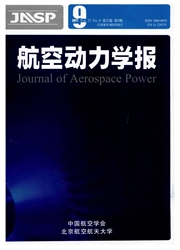

 中文摘要:
中文摘要:
采用数值模拟求解Navier-Stokes(N-S)方程的方法研究了小幅值分布式粗糙度对马赫数为4.5的平板边界层中扰动演化的影响.用泰勒展开线性化的办法将边界条件取在光滑平板壁面上,来模拟小幅值分布式粗糙度.研究了粗糙度及扰动的不同因素对边界层扰动演化的影响,其中包括粗糙度高度、波长、粗糙度区域的长度及扰动波频率等.研究结果表明:分布式粗糙度通过改变边界层基本流场影响扰动波的幅值演化,一定幅值的分布式粗糙度会使粗糙度区域前的不稳定区向低频移动,使粗糙度区域后的不稳定区向高频移动.从总体效果上看,对于通过粗糙度时,靠近中性曲线下支界相对低频的扰动,粗糙度会抑制其幅值的增长;对于靠近中性曲线上支界相对高频的扰动,粗糙度会促进其幅值的增长.
 英文摘要:
英文摘要:
The influence of small distributed surface roughness on disturbance amplifica- tion in a Mach 4.5 Blasius boundary layer was investigated by numerical simulation of Navi- er-Stokes (N S) equations. Distributed roughness was simulated by applying the wall bound- ary condition onto the smooth wall through a method of Taylor expansion. Different parame- ters of roughness and disturbance were considered including height, spacing, length of roughness and frequency of disturbances. Results show that distributed roughness affects the disturbance amplification by altering the basic flow. Distributed roughness shifts the unsta ble area to lower frequency for upstream flow field and to higher frequency for downstream flow field. Generally, for lower frequency disturbances near the lower branch of the neutral stability curve in the vicinity of roughness, the amplification was damped, while for higher frequency disturbances near the upper branch of the neutral stability curve, the amplification was amplified.
 同期刊论文项目
同期刊论文项目
 同项目期刊论文
同项目期刊论文
 期刊信息
期刊信息
